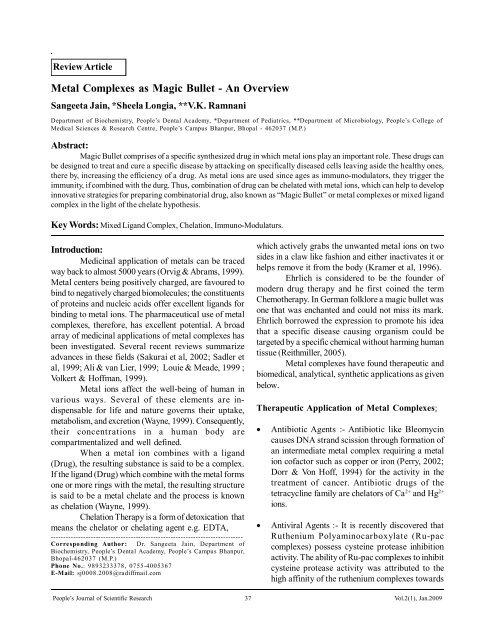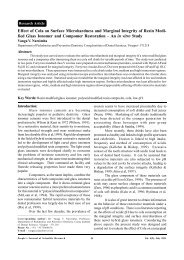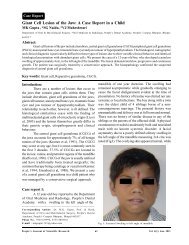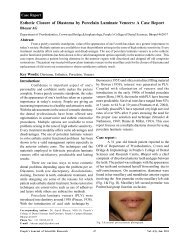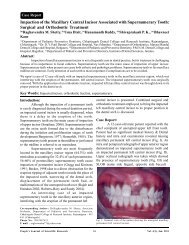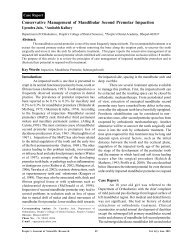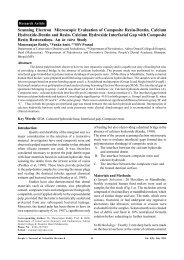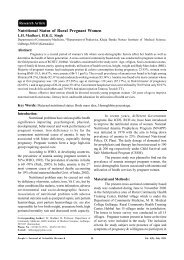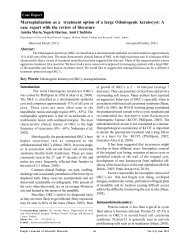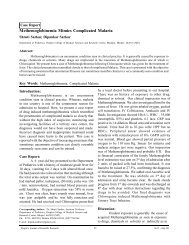Metal Complexes as Magic Bullet - People's Journal Of Scientific ...
Metal Complexes as Magic Bullet - People's Journal Of Scientific ...
Metal Complexes as Magic Bullet - People's Journal Of Scientific ...
You also want an ePaper? Increase the reach of your titles
YUMPU automatically turns print PDFs into web optimized ePapers that Google loves.
Review Article<strong>Metal</strong> <strong>Complexes</strong> <strong>as</strong> <strong>Magic</strong> <strong>Bullet</strong> - An OverviewSangeeta Jain, *Sheela Longia, **V.K. RamnaniDepartment of Biochemistry, People’s Dental Academy, *Department of Pediatrics, **Department of Microbiology, People’s College ofMedical Sciences & Research Centre, People’s Campus Bhanpur, Bhopal - 462037 (M.P.)Abstract:<strong>Magic</strong> <strong>Bullet</strong> comprises of a specific synthesized drug in which metal ions play an important role. These drugs canbe designed to treat and cure a specific dise<strong>as</strong>e by attacking on specifically dise<strong>as</strong>ed cells leaving <strong>as</strong>ide the healthy ones,there by, incre<strong>as</strong>ing the efficiency of a drug. As metal ions are used since ages <strong>as</strong> immuno-modulators, they trigger theimmunity, if combined with the durg. Thus, combination of drug can be chelated with metal ions, which can help to developinnovative strategies for preparing combinatorial drug, also known <strong>as</strong> “<strong>Magic</strong> <strong>Bullet</strong>” or metal complexes or mixed ligandcomplex in the light of the chelate hypothesis.Key Words: Mixed Ligand Complex, Chelation, Immuno-Modulaturs.Introduction:Medicinal application of metals can be tracedway back to almost 5000 years (Orvig & Abrams, 1999).<strong>Metal</strong> centers being positively charged, are favoured tobind to negatively charged biomolecules; the constituentsof proteins and nucleic acids offer excellent ligands forbinding to metal ions. The pharmaceutical use of metalcomplexes, therefore, h<strong>as</strong> excellent potential. A broadarray of medicinal applications of metal complexes h<strong>as</strong>been investigated. Several recent reviews summarizeadvances in these fields (Sakurai et al, 2002; Sadler etal, 1999; Ali & van Lier, 1999; Louie & Meade, 1999 ;Volkert & Hoffman, 1999).<strong>Metal</strong> ions affect the well-being of human invarious ways. Several of these elements are indispensablefor life and nature governs their uptake,metabolism, and excretion (Wayne, 1999). Consequently,their concentrations in a human body arecompartmentalized and well defined.When a metal ion combines with a ligand(Drug), the resulting substance is said to be a complex.If the ligand (Drug) which combine with the metal formsone or more rings with the metal, the resulting structureis said to be a metal chelate and the process is known<strong>as</strong> chelation (Wayne, 1999).Chelation Therapy is a form of detoxication thatmeans the chelator or chelating agent e.g. EDTA,-----------------------------------------------------------------------------Corresponding Author: Dr. Sangeeta Jain, Department ofBiochemistry, People’s Dental Academy, People’s Campus Bhanpur,Bhopal-462037 (M.P.)Phone No.: 9893233378, 0755-4005367E-Mail: sj0008.2008@radiffmail.comwhich actively grabs the unwanted metal ions on twosides in a claw like f<strong>as</strong>hion and either inactivates it orhelps remove it from the body (Kramer et al, 1996).Ehrlich is considered to be the founder ofmodern drug therapy and he first coined the termChemotherapy. In German folklore a magic bullet w<strong>as</strong>one that w<strong>as</strong> enchanted and could not miss its mark.Ehrlich borrowed the expression to promote his ideathat a specific dise<strong>as</strong>e causing organism could betargeted by a specific chemical without harming humantissue (Reithmiller, 2005).<strong>Metal</strong> complexes have found therapeutic andbiomedical, analytical, synthetic applications <strong>as</strong> givenbelow.Therapeutic Application of <strong>Metal</strong> <strong>Complexes</strong>:Antibiotic Agents :- Antibiotic like Bleomycincauses DNA strand scission through formation ofan intermediate metal complex requiring a metalion cofactor such <strong>as</strong> copper or iron (Perry, 2002;Dorr & Von Hoff, 1994) for the activity in thetreatment of cancer. Antibiotic drugs of thetetracycline family are chelators of Ca 2+ and Hg 2+ions.Antiviral Agents :- It is recently discovered thatRuthenium Polyaminocarboxylate (Ru-paccomplexes) possess cysteine prote<strong>as</strong>e inhibitionactivity. The ability of Ru-pac complexes to inhibitcysteine prote<strong>as</strong>e activity w<strong>as</strong> attributed to thehigh affinity of the ruthenium complexes towardsPeople’s <strong>Journal</strong> of <strong>Scientific</strong> Research 37 Vol.2(1), Jan.2009
<strong>Metal</strong> <strong>Complexes</strong> <strong>as</strong> <strong>Magic</strong> <strong>Bullet</strong> - An Overview ------------------------------- S Jain, S Longia & VK Ramnani.binding the SH group in the cysteine residue of theenzymes via a rapid aqua substitution reaction.The discovery of the prote<strong>as</strong>e inhibition activity ofRu-pac-complexes may be of significance indeveloping antiviral agents in which Ru-paccomplexes could act <strong>as</strong> metallo-inhibitor agents fordise<strong>as</strong>e progression (Chaterjee et al, 2006).The [Ru (pac) (No)] complexes offer a number offeatures <strong>as</strong> nitric-oxide (NO) carriers or scavengers.(Fark<strong>as</strong> & Sovago, 2002).Anticancer Agents :- Cisplatin, Carboplatin are thefirst and second generation platinum drugrespectively, which are widely used in the treatmentof cancer (Kostova, 2006).The synthesis of a tripeptide conjugate of cisplatin(Pil & Lippard, 1997) h<strong>as</strong> been reported and it w<strong>as</strong>suggested that similar species can be used toovercome the tumour resistance of platinum drugs.In another report the preparation of cyclopeptidemetal complex conjugates h<strong>as</strong> been described usingthe reaction between linear peptides of cysteine and[Pt (terpy)].The high affinity of platinum for sulphur binding w<strong>as</strong>used in this strategy and it w<strong>as</strong> proposed thatcomplexes of [Pt(terpy)] can be considered <strong>as</strong> bothprotecting and promoting groups for peptidecyclisation. (Fark<strong>as</strong> & Sovago, 2002,)Many questions remain <strong>as</strong> to how platinum drugscarry out their antineopl<strong>as</strong>tic (antitumor) activity.Scientists believe that rational design techniques willlead to better platinum containing agents that havefewer toxic side effects, overcome all types ofresistance, and are efficacious in different tumourtypes (Kostova, 2006).Many of the properties of the ruthenium agentstested are similar to that of platinum compoundsthat is, they bind to DNA (preferentially to guanineresidues). Their DNA binding properties are affectedby physiological sulfur ligands, such <strong>as</strong> glutathioneand multiple ruthenium oxidation states and thisligand system appear to have anticancer activity.(Sava et al, 1984)Octahedral Ru(II), and Ru(III) complexescontaining ligands, such <strong>as</strong> amines, N-heterocyclesand dimetyl sulfoxides exhibited various degree ofbiological activity including antitumour action in-vivo(Sava et al, 1984).Antiarthritic Agents:- Auranofin and other gold (I)complexes are well known <strong>as</strong> antiarthritic drugs,butthey also inhibit the growth of cultured tumour cells“in-vitro” and many have antimitochondrial activity(Mckeage, 2002).Auranofin h<strong>as</strong> recently become known <strong>as</strong> a potentand specific inhibitor of thioredoxin reduct<strong>as</strong>e(Gromer et al,1998), an enzyme that may play animportant role in the redox control of thepermeability of mitochondrial membranes(Rigobello et al,1998).Biomedical, Synthetic and Analytical Applicationof <strong>Metal</strong> <strong>Complexes</strong>:The use of metal complexes in clinicaldiagnostic imaging is incre<strong>as</strong>ing tremendously. Theseapplications involve gamma scintigraphy, positronemission tomography (PET), Magnetic ResonanceImaging (MRI) and metal b<strong>as</strong>ed radiopharmaceuticals(Fark<strong>as</strong> & Sovago, 2002).The high level expression of som<strong>as</strong>tostatinreceptors (SSTR) on various tumour cells h<strong>as</strong> providedthe molecular b<strong>as</strong>is for successful use of radiolabelledoctreotide, lantreotide analogs <strong>as</strong> tumour tracers innuclear medicine (Virgolini et al, 2002). Other (nontumoral) potential indications for SSTR scintigraphyare b<strong>as</strong>ed on an incre<strong>as</strong>ed lymphocyte binding at sitesof inflammatory or immunologic dise<strong>as</strong>es such <strong>as</strong>thyroid <strong>as</strong>sociated eye changes (Blum et al, 2002).A plentitude of preclinical data and clinicalstudies confirm their potential use in diagnosis <strong>as</strong> well<strong>as</strong> “Proof-of-principle” for therapy of cancer patients(Virgolini et al, 2002).Compounds of Vanadium are essential nutrientsfor higher animals, while in humans they show insulinlike properties. The biological significance of zinc fingerpeptides and metallothioneins have given a great impetusto further studies on the metal-ion-sulphur co-ordination(Sakurai et al, 2002).Spectroscopic monitoring of the metal binding inzinc finger peptide is a crucial point for the structuralelucidation of these complexes. It h<strong>as</strong> been reported thatultraviolet Resonance Roman Spectroscopy (UVRR) canbe used for simultaneous monitoring of cysteine andhistidine co-ordination and promise a wide range ofapplication. Several papers have been published on thepreparation and reactivity of ferrocenoyl peptides andrelated molecules, which can be used <strong>as</strong> redox markersand synthetic probes or for the selective monitoring ofbio-molecules (Fark<strong>as</strong> & Sovago, 2002).People’s <strong>Journal</strong> of <strong>Scientific</strong> Research 38 Vol.2(1), Jan.2009
<strong>Metal</strong> <strong>Complexes</strong> <strong>as</strong> <strong>Magic</strong> <strong>Bullet</strong> - An Overview ---------------------------------- S Jain, S Longia & VK Ramnani.The biomedical applications of peptides <strong>as</strong>effective ligands for radiolabelled molecules or imagingagents received special interest. 99m TC is probablythe most commonly used radioactive isotope in medicalimaging, while the chemically related 186 Re /188 Reisotopes are promising candidates for internalradiotherapy (Blum et al, 2002).Technetium and rhenium complexes of peptidesand derivatives were studied by several research groups(Fark<strong>as</strong> & Sovago, 2002). An important development inthe coordination chemistry of peptides is that peptidecomplexes are frequently attached to other biomoleculesand the resulting species can be used <strong>as</strong> sensors or markersfor analytical and biomedical purposes.Conclusion:Recent advances in chelation research havepaved the way for tragetting “magic-bullets” forchemotherapy, using different strategies andpharmacological manipulation, demonstrate significantprospects for the utilization of metal complexes <strong>as</strong> drugsand presenting a flourishing arena for medical inorganicbiochemistry.Application of new methodologies such <strong>as</strong>combinatorial drug chemistry will be beneficial for thedevelopment of newer drug. It needs to be determinedto what extent toxicity of normal tissue will limit theapplication of chelation b<strong>as</strong>ed therapies in clinical trials.Perhaps, chelation-b<strong>as</strong>ed treatment will need to betailormade for each patient or group of patient and oneshould also take into consideration the emergence ofresistance to treatment.The great success of platinum compoundsserendipitously discovered to have antitumor behaviour,should be an inspiration to scientists who continue thequest to find the “<strong>Magic</strong>-<strong>Bullet</strong>” cure for cancer, solong anticipated and so long in realization. Therefore, acombination of current conventional and chelationtargeted events seems a more likely successful scenario.Bibliography:1. Ali H, van Lier JE: <strong>Metal</strong> complexes <strong>as</strong> photo and radiosensitizers. Chemical Reviews, 1999; 99:2379-450.2. Blum J, Handmaker H, Rinne A: Technitium Labelledsmall peptide radiopharmaceuticals in the identificationof lung cancer. Current Pharmaceutical Design, 2002 ;8(20), 1827-1836.3. Chaterjee D, Mitra A, Dey GS: RutheniumPolyaminocarboxylate <strong>Complexes</strong>:Prospects for their use<strong>as</strong> metallopharmaceuticals. Platinum <strong>Metal</strong>s Review,2006;50(1):2-12.4. Dorr RT, Von-Hoff DD: Drug Monographs In: CancerChemotheraphy Hand Book, 2 nd Edn., Norwalk,Connecticut : Appleton & Lange, 1994;pp.227-236.5. Fark<strong>as</strong> E, Sovago I : <strong>Metal</strong> complexes of aminoacidsand peptides. In: Amonoacids, peptides & protiens.Royal society of chemistry, Special PeriodicalReports, 2002; 33 : 295-364.6. Gromer S, Arscott LD, Williams CH, Schirmer RH ,Becker K: Human placenta thioredoxine reduct<strong>as</strong>e.Isolation of the seleno-enzyme, steady state kinetics,and inhibiton by theraupeutic gold compounds,<strong>Journal</strong> of biological chemistry, 1998;273(32):20096.20101.7. Kramer U, Cotter-Howells JD, Charnock JM, Baker AJM,Smith JAC: Free histidine <strong>as</strong> metal chelator in plants thataccumulates nickel. Nature, 1996; 379 : 635-638.8. Kostova I: Platinum complexes <strong>as</strong> anticancer agentsRecent patents on anticancer drug discovery, 2006; 1: 1-22.9. Louie AY, Meade TJ: <strong>Metal</strong> complexes <strong>as</strong> enzymeinhibitors. Chemical Reviews, 1999;999:2711-2734.10. Mckeage MJ: Gold opens mitochondrial pathways toapoptosis. British <strong>Journal</strong> of Pharmacology, 2002;136: 1081-1082.11. Orvig C, Abrams MJ: Medicinal inorganicchemistry:introduction. Chemical Reviews, 1999;99:2201-2204.12. Paul Ehrich: Wikipedia, the free encyclopedia.13. Perry M: The chemotherapy source book, Bleomycinsulfate product monograph. In: BC Cancer agency,cancer drug manual. Williams & Wilkins, Philadelphia, Lippinocott, 2002;pp.237-239.14. Pil P, Lippard SJ : Cisplatin and Related Drugs. In :“Encyclopedia of Cancer” J.R. Bertino Eds., AcademicPress, San Diego, CA, 1997;1: 392-410.15. Rigobello M.P., Callegaro M.T., Barzone, Benett M. &Bindoli A, : Purification of mitochondrial thioredoxinreduct<strong>as</strong>e and its involvement in the redox regulationof memberane permeability. Free radical Biology andMedicine, 1998; 15 (24) : 370-376.16. Reithmiller S: From Atoyl to Salvarsan : Searching forthe <strong>Magic</strong> <strong>Bullet</strong>. International <strong>Journal</strong> ofExperimental and clinical chemotherapy 2005 : 51 :5; 234-242.17. Sadler PJ, Li H, Sun H: Coordination chemistry of metalsin medicine: target sites for bismuth. CoordinationChemical Reviews, 1999;185-186:689-709.18. Sakurai H, Kojima Y, Yoshikawa Y, Kawabe K, Y<strong>as</strong>ui H: Antidiabetic vanadium (IV) and zinc (II) complexes.Coordination Chemistry Reviews, 2002; 226 : 187-198.19. Sava G, Zorzet S, Giraldi T, Mestroni G, Z<strong>as</strong>sinovich G:Antineopl<strong>as</strong>tic activity and toxicity of an Organame-People’s <strong>Journal</strong> of <strong>Scientific</strong> Research 39 Vol.2(1), Jan.2009
<strong>Metal</strong> <strong>Complexes</strong> <strong>as</strong> <strong>Magic</strong> <strong>Bullet</strong> - An Overview ------------ S Jain, S Longia & VK Ramnani.tallic complex of ruthenium (II) in comparision with Cis-POD in mice bearing solid malignant neopl<strong>as</strong>ms.European <strong>Journal</strong> of Cancer & Clinical Oncology,1984;20(6): 841-847.20. Virgolini I, Traub T, Novotny C, Leimer M, Fuger B, Sr.Li SR, Patri P, Pangerl T, Angelberger P, Raderer M,Burgg<strong>as</strong>ser G, Andreae F, Kurtaran A, Dudczak R:Experience with Indium-111 & Yttrium 90-labelledsoatostatin. Current Pharmaceutical Design, 2002; 48 :1781-1807.21. Volkert WA, Hoffman TJ: Therapeutic radiopharmaceuticals.Chemical Reviews, 1999;99: 2269-2292.22. Wayne RB : Iron transport and storage inmicroorganisms, plants and animals. <strong>Journal</strong> of theAmerican College of Nutrition, 1999;18 (1): 368-369.People’s <strong>Journal</strong> of <strong>Scientific</strong> Research 40 Vol.2(1), Jan.2009


